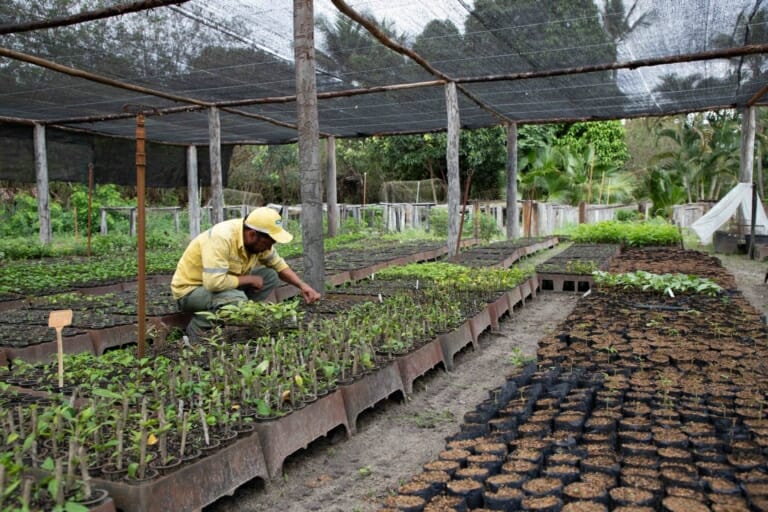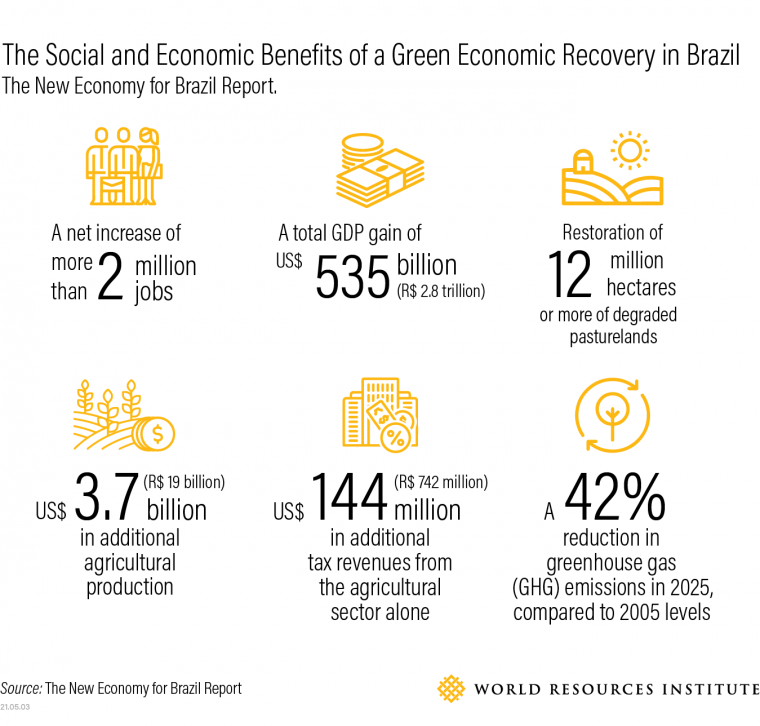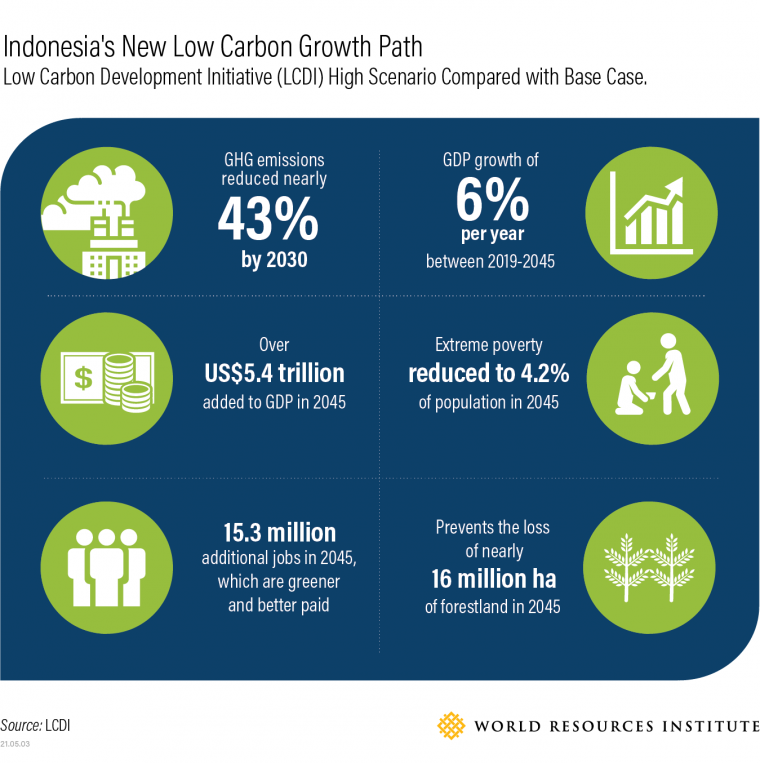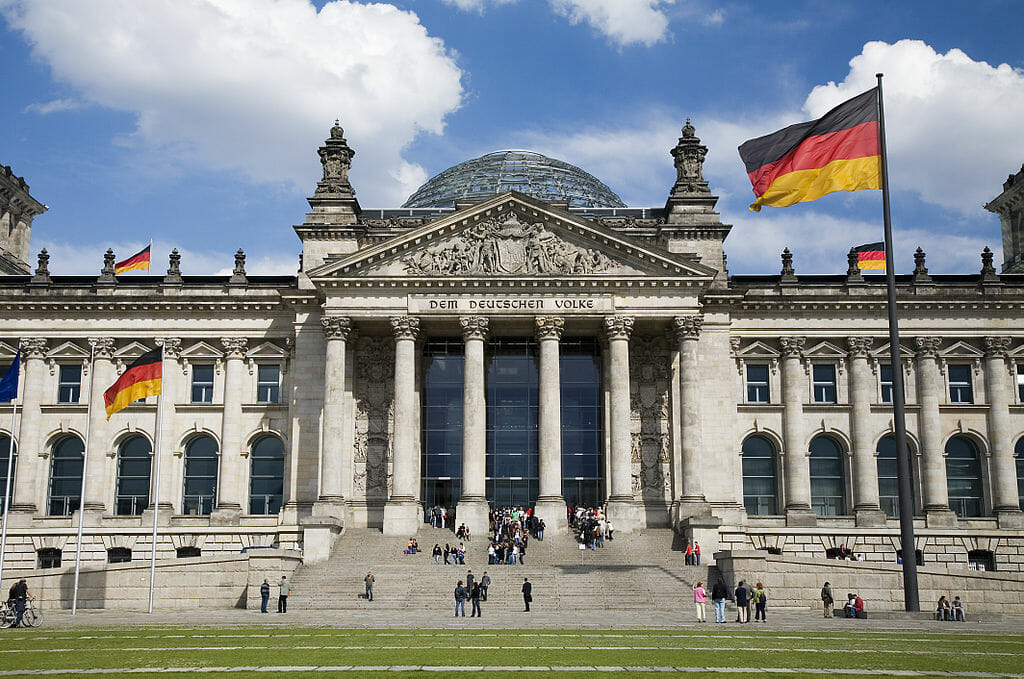Leaders around the world are seeking to address the health and economic fallouts of the COVID-19 crisis, while also confronting the reality of the climate crisis. Responding to this combination of crises will require decisive action. Recent analyses suggest that implementing green strategies for pandemic recovery along with ambitious climate policies can have positive short-run and long-term effects in terms of jobs, poverty reduction, GDP growth, and social and equity goals.
Evidence from Oxford University demonstrates that economic recovery policies can effectively deliver both economic and climate benefits. IEA’s Sustainable Recovery Plan shows that investing $1 trillion (0.7% of global GDP) each year between 2021-2023 in six key energy sectors (transportation, industry, electricity, fuels, buildings and emerging low-carbon technologies) could increase worldwide economic growth by 1.1% each year — boosting jobs faster than what would be achieved with investments in the fossil fuel sector.
At the same time, the list of countries pledging ambitious climate action by submitting enhanced Nationally Determined Contributions (NDCs) as part of their commitments to the Paris Agreement and establishing net-zero emissions targets is growing. As of early 2021, 59 countries responsible for 53% of global greenhouse gas (GHG) emissions had set targets to zero out their emissions, most committing to do so by 2050. This includes more than half of the G20 economies.
While some major economies, notably the European Union and more recently the United States, have announced major green economic stimulus packages, emerging and developing economies can also benefit from low-carbon plans to reboot their economies in the wake of COVID-19. A number are already moving in this direction — from Colombia to Nigeria to South Korea.
Far from being a hindrance, green growth is, in fact, a proven economic driver. A growing evidence base from WRI, the New Climate Economy project and others shows this to be the case globally as well as in individual countries. Below, we highlight what the research shows us about moving towards low-carbon economic paths that support green recoveries in both Brazil and Indonesia, and what is needed to seize the moment.
Green Recovery in Brazil: Quality Infrastructure, Innovative Industry and Sustainable Agriculture
Brazil faces a growing threat of extreme weather events. In 2017, about 49% of Brazilian municipalities were affected by droughts and 31% were affected by flooding. In 2020, torrential rains in Brazil’s Southeast caused floods and mudslides that displaced 30,000 people. Current deforestation rates have prompted domestic and international backlash, and could reach a tipping point that threatens rainfall patterns and he country’s agricultural sector.
Unfortunately, Brazil’s updated NDC submitted in December 2020 falls far short of the bold ambition needed to avert a climate crisis and move the country towards a more sustainable, inclusive development path. During the Leaders Climate Summit in April, Brazilian President Bolsonaro announced the country would aim to reach carbon neutrality by 2050 instead of 2060 as declared in the December NDC. He also reiterated recent pledges to end illegal deforestation by 2030 through additional funds for law enforcement and investing in land governance. While this rhetoric is encouraging, meaningful action is necessary to demonstrate Brazil’s commitment to climate mitigation, especially given that these new commitments contradict many of the environmental decisions taken by his administration in the last two years.
Research from the New Economy for Brazil initiative, led by WRI Brazil and the New Climate Economy, in partnership with Brazilian experts and institutions, shows that such a path is not only attainable, but actually delivers better economic and social impacts. The initiative’s inaugural report, A New Economy for a New Era, found that by 2030, a low-carbon, climate-resilient economic recovery in Brazil could yield a net increase of more than 2 million jobs and a total GDP gain of $535 billion (R$ 2.8 trillion) compared to a business-as-usual path, with the net benefits starting from the very first year. Such a transition could also lead to reductions in both air and water pollution, delivering major health benefits for Brazilians and a 42% reduction in GHG emissions in 2025, compared to 2005 levels. It lays out how, by focusing on quality infrastructure, innovative industry and sustainable agriculture, a green recovery for Brazil is possible. These three sectors have been key powerhouses within the Brazilian economy and would become more productive and competitive in a low-carbon transition, while also attracting much-needed private and international investment.
Electric buses are one opportunity for the development of low-carbon industry and competitiveness in Brazil. Not only can jobs be created throughout the e-bus production chain, but investment in such public transit also reduces local air pollution and its impact on public health. Air pollution causes around 50,000 deaths each year in Brazil, equivalent to the annual death toll from violence and traffic accidents.
In 2020, Brazil’s agricultural sector was responsible for one in every three jobs in the country and 26.6% of national GDP. The sector needs to decouple from deforestation, however, if it wants to remain competitive in the international market. Agricultural expansion that is deforestation-free is feasible. In Brazil, restoring more than 12 million hectares of degraded pasturelands for more productive uses would require an investment of approximately $4.5 billion, but by 2030 could generate a return on investment of $3.6 billion and provide an additional $134 million in tax revenues. Reforestation represents another economic opportunity: Reforesting degraded lands with native species and agroforestry systems has a rate of return around 12%, similar to that of eucalyptus and permanent crops.
Indonesia’s Opportunities and Challenges in Transitioning to a Low-carbon Economy
Since Indonesia’s National Development Planning Ministry, BAPPENAS, launched the Low Carbon Development Initiative (LCDI) in 2017, it has taken the lead on integrating low-carbon activities into the country’s economic development plans. The initiative’s 2019 report found that a more ambitious low-carbon path in Indonesia can create higher, more sustained economic growth as well as social and environmental benefits.
A sustainable and inclusive long-term growth course could deliver 15 million green jobs by 2045, as well as an average GDP growth rate of 6% a year until 2045 — higher than the current business-as-usual track, and with net benefits starting in the first year. This low-carbon path could also help Indonesia exceed the 29% emissions-reduction target in its NDC, reducing the country’s GHG emissions by nearly 43% by 2030. In addition, this development plan would reduce poverty rates, help avoid 40,000 deaths from air pollution each year, and bridge gender and regional development gaps.
Based on the work so far, a low-carbon development approach has been integrated into Indonesia’s mid-term development plan 2020-2024, making the nation one of the first in the world to incorporate low-carbon policymaking into national economic development plans. In fact, GHG emissions reductions is now one of the main macroeconomic indicators that will be used to measure progress in the economic development plan, alongside economic growth, unemployment and poverty reduction.
Related Articles: What the Next Generation Needs From a Green Recovery | Green Recovery Know-How From the Nordics
Despite challenges in terms of bureaucratic coordination, financial support and the pandemic, BAPPENAS has made low-carbon development a priority program in the government’s annual work plan to build back better after COVID. Minister of Finance Sri Mulyani has also highlighted the key role of government policies in fostering transitions to a green economy, even though the government did not directly reflect green economy and green investment as the main focus in the FY2021 Budget.
The initial LCDI economic modelling analysis by BAPPENAS, with the support of WRI and NCE, is now being updated to reflect COVID-19 economic realities — including an economic contraction of 2.1% in 2020 — and the potential benefits of a green recovery. Minister Suharso Monoarfa of BAPPENAS recently explained that in the ministry’s latest analysis, a mid-century, net-zero-emission scenario would achieve GDP growth and income per capita that are 2.5 times higher compared to a business-as-usual scenario between 2021-2070. BAPPENAS is also developing a green fiscal stimulus program that supports Indonesia’s transition to a green economy. The program focuses on energy, farming and waste management, and is expected to generate jobs while reducing GHG emissions.
On the other hand, the government also fast-tracked the enactment of Indonesia’s first “Job Creation” omnibus bill during the COVID crisis, ultimately rewriting 73 sectoral laws that relax investment requirements. This law may potentially compromise environmental and labor standards in favor of economic growth and investment. Efforts to improve collaboration are now underway through BAPPENAS along with other ministries, aiming to identify measures that could realize the benefits of a green recovery going forward. Politically, however, this is not easy to advance given the prominence of some traditional industries and differing agendas across ministries.
Seizing the Moment to Rebuild After COVID-19
The examples of Brazil and Indonesia are not outliers; they are indicators of the very real opportunities that exist in countries around the world.
Nigeria’s COVID-19 stimulus package allocated close to $619 million for a solar systems project that will provide energy to 5 million households now without power. Meanwhile, stimulus packages in China have included a focus on “new infrastructure” — including low-carbon transport, rail systems, electric vehicle charging stations and ultra-high voltage electricity transmission. WRI analysis finds that with more ambitious climate action, China could peak its carbon emissions by 2026, and by 2050, could prevent 1.89 million premature deaths and generate nearly $1 trillion in net economic and social benefits. Colombia’s recovery plan includes nature-based solutions such as reducing deforestation, restoring degraded lands and developing public green spaces. The plan also allocates $4.7 billion to accelerate 27 renewable energy and transmission projects, aiming to create 55,000 jobs. Building on these opportunities, even in the midst of the global pandemic, China announced a commitment to aim for net-zero emissions across its economy by 2060, and Colombia announced a very ambitious enhanced NDC.
Many other actors — investors and businesses in particular — are recognizing and seizing this opportunity. More than 1,400 major businesses have signed on to the Science Based Targets initiative, committing to reduce their emissions in line with what the science says is necessary. Even before the COVID-19 crisis, private investors had begun shifting away from high-carbon infrastructure. Now, they are seizing the opportunity to rebuild with climate-smart initiatives. Global financial institutions are moving away from coal and committing to net-zero investment portfolios. For example, the Glasgow Financial Alliance for Net Zero (GFANZ) brings together 160 asset owners, asset managers and banks, together responsible for assets in excess of $70 trillion, that have committed to align their investments to net zero by 2050 or sooner.

National Action, International Support
There is growing awareness that we should not return to the same flawed economic systems as before. National economic recoveries offer openings to build back better for a low-carbon, inclusive and resilient future. While many countries, including Brazil and Indonesia, have put forward stimulus packages that include support for carbon-intensive activities, others such as South Korea, China and Canada have been moving towards greener recovery plans.
Such domestic policies can also support climate ambition. By enhancing their NDCs, countries can bolster national efforts to create jobs, become competitive in the industries of the future, reduce health risks and build resilience following the pandemic. COVID-19 has made us more aware of how interconnected we are — to each other and to nature. We are more cognizant of how threats to our societies and economies can emerge, whether it be new pandemics or the increased frequency and intensity of natural disasters sparked by climate change.
What is needed now is international support to help countries realize this vision — most urgently for small, vulnerable, low-income countries, many of which are on the forefront of efforts to increase ambitious climate action. Unlike many industrial nations, emerging economies such as Brazil and Indonesia face constraints to expanding investments and may also need support. For example, while a more ambitious low-carbon pathway will deliver net economic and development benefits from the first year in Indonesia, it will also require greater investments initially — as much as $22 billion per year (1.7% of the GDP). It will be essential to work with the international community and private finance sector to deliver these much-needed investments. Creating budgetary space and reducing the balance of payment pressures, for example, will be essential for low-income countries to recover — one area where the international community can help significantly.
The international community can also help identify pipelines of sustainable projects and help countries access green credit and securities markets. As nations formulate a green economy roadmap and green fiscal stimulus for specific sectors, international collaboration and support will be key to making plans a reality. And as national and international investors increasingly move away from high-risk, unsustainable projects, opting for a sustainable, low-carbon recovery can allow countries like Brazil and Indonesia to access the increasing green finance and investment opportunities.
This is the moment for all countries to move towards sustainable, inclusive, low-carbon and resilient economies and integrate climate action into their economic recovery policies. By doing so, they can deliver on climate goals and seize the opportunity to build a greener, fairer and more resilient future for all.
— —
About the authors: Arief Wijaya is the Climate, Forests, and the Oceans Senior Manager of WRI Indonesia. Carolina Genin is the Climate Director at WRI Brasil. Helen Mountford is the Vice President for Climate and Economics at WRI. Ginette Walls supports WRI United States’ work with the Global Covenant of Mayors, particularly relating to the openness of environmental and climate data. Egi Suarga is a manager for Indonesia Low Carbon Development Initiative (LCDI).
Editor’s Note: The opinions expressed here by Impakter.com columnists are their own, not those of Impakter.com. — In the Featured Photo: Local people of Gede Pangrango, Dadin, a 45 year old man, fishing in the lake using a traditional net to meet his needs everyday life. Featured Photo Credit: Ricky Martin/CIFOR.











